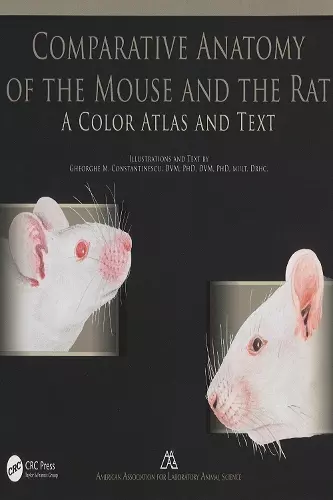Comparative Anatomy of the Mouse and the Rat
A Color Atlas and Text
Gheorghe M Constantinescu author
Format:Paperback
Publisher:Taylor & Francis Ltd
Published:5th Apr '18
Currently unavailable, and unfortunately no date known when it will be back

Key features:
Comparative Anatomy of the Mouse and Rat: a Color Atlas and Text provides detailed comparative anatomical information for those who work with mice and rats in animal research. Information is provided about the anatomical features and landmarks for conducting a physical examination, collecting biological samples, making injections of therapeutic and experimental materials, using imaging modalities, and performing surgeries.
As the title suggests, this is an in-depth anatomy textbook. It is ring bound, so it lies flat and fits nicely on a mayo stand in surgery, or on a counter during a postmortem evalu- ation. This book is visually appealing as it has many detailed, well- done, full color drawings of mouse and rat anatomy throughout. Topics are covered that I didn't expect, such as the detailed section on Juvenile Features, which includes drawings of mouse and rat pups at < 24 hours, 5 days, 11 days, 21 days, and adult, explaining how you would sex each species at each age. This book is endorsed by the American Association of Laboratory Animal Science (AALAS), and the value of this book for laboratory animal veterinarians is clear. I do, however, feel that this book could also be a valuable resource for clinical practitioners. As an exotic animal veterinarian, for example, I was very interested to see the detailed drawings of the mammary glands. Mammary gland tumors are a common issue in mice and rats, so it is good to be able to appreciate how far that tissue extends from the ventral area and the actual papillae. Many of the other sections would be useful in establishing the locations of structures for radiographs, surgery, sample collection, catheter placement, etc.
Overall, I found this book to be very interesting, visually appealing, and a detailed exploration of the anatomy of the mouse and rat, with the differences between the species clearly highlighted in the text. This textbook would be a useful reference for laboratory animal veterinarians and exotic animal practitioners.
Reviewed by Teresa Bousquet, DVM, Park Veterinary Centre, Alberta for The Canadian Veterinary Journal, March 2019.
ISBN: 9781138624030
Dimensions: unknown
Weight: 860g
276 pages